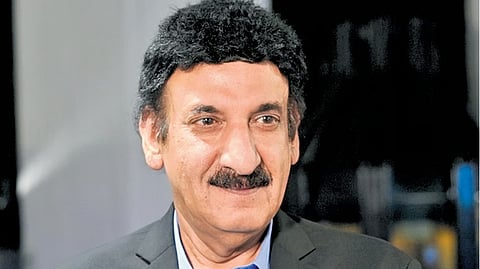
- LIFESTYLE
- FASHION
- FOOD
- ENTERTAINMENT
- EVENTS
- CULTURE
- VIDEOS
- WEB STORIES
- GALLERIES
- GADGETS
- CAR & BIKE
- SOCIETY
- TRAVEL
- NORTH EAST
- INDULGE CONNECT

The lobby of Le Meridien in Delhi is packed. Several high-profile events are taking place simultaneously and there are handshakes, air-kissing, the sound of clinking glasses all around. The setting is sophisticated, as it usually is, in one of Delhi’s premier five-star hotels. In the middle of all this, is a large and vibrant poster announcing a show by Gogia Pasha, the “Gilly Gilly Wonderman”, who is also the “World’s Greatest Magician”!
The poster, a lithograph from the 1950s, shows the turbaned head of the renowned magician who is sporting his trademark Cheshire-cat-grin. Hand-painted by artist Bhuskute, it features writing in English, Urdu and Hindi, signalling the popularity of Pasha, and one is taken back to a time when people were spellbound by the likes of Pasha, whose performances in gigantic tents pulled audiences from faraway places.
The poster of the magic show is only one among 30 others, all equally vintage and magnificent, that is on display, as part of the exhibition titled ‘Journey Through Time: +1 Day, +1 Story’. All the posters, some of them dated from the 1920s, are from the archives of Tarun Thakral, the executive director of Le Meridien, Delhi. A veteran hotelier with over 35 years of experience in the hospitality industry in India and abroad, Thakral is also a lover of old things. He founded, in 2013, the Heritage Transport Museum in Gurugram, which houses over 3,500 curated objects that present India’s colourful transport history.
Local to global
For Thakral, the posters, almost all of which were hand-drawn and painted, are works of art that transcend their commercial purposes. “Each piece on display offers a sneak peek into social evolution, consumer trends and artistic expressions of the times they were produced in,” he says. They are “time capsules” that open a window into the bustling marketplaces of the past, chronicling the evolution of the art of advertising over the years.
The posters present products and services ranging from the indigenous to the international. There are advertisements of ‘Sri Kaliswari Fireworks’ of Sivakasi and ‘Anandha Rosewater’ of Madras, Tamil Nadu, featuring elaborately bejewelled women and intricate floral designs, as well as ones of Air-India and Air-France, which are largely minimalistic and some rather abstract. “Half of these posters are sourced from across India, while the other half is from across the globe, including the UK, the US, Germany and France,” says Thakral.
For Thakral, who says that the posters are part of a larger collection he’s building, which includes calendar art and various pieces of bazaar art among other things, the exhibition is a project to promote an attitude of preservation. His interest in vintage posters began during the pandemic and has only grown since then. “Most of these posters were hand-made by artists and then were printed using techniques like lithography. Those techniques are now largely gone. We have to preserve these works that hold great historical and artistic value, or they would be lost forever. I am also in the process of digitising and cataloguing what I have collected,” says Thakral.
The collector’s passion
The pursuit of posters has taken him across the country and around the globe. He says that people in Rajasthan have a peculiar fondness for all things vintage. He acquired quite a few pieces from the state alone, including a poster of ‘Mobil Oil’ from the ’50s, which is on display. “You can find a lot of small-time dealers of old things in Rajasthan,” he says. “They don’t throw away anything. Even letters that are a hundred years old, they keep.” The exhibition features, largely to the surprise of visitors, works by some of the biggest names in India’s art history, including advertisements painted by the likes of MV Dhurandhar and Raghuvir Mulgaonkar. They hark back to the colonial times and present snapshots of royalty. Dhurandhar’s painting of ‘The Great Indian Peninsular Railway’ from the 1930s shows a man with a crown being heralded on a white horse with a procession of traditionally clad Indian women and men following him. Given his passion for India’s transport history, the series of Indian Railway posters, Thakral admits, is his favourite as well.
Bridging the past and the present
Another poster, advertising Darjeeling for ‘Eastern Bengal Railway’, from the 1920s, is a work by the British artist V Veevers, and depicts in vibrant colours two smiling Buddhist monks. “When I posted the Veevers poster on Facebook, his granddaughter, who lives in the US, came across it and messaged me saying that he was hired by the Indian Railways to make paintings and passed on other information about the artist as well,” says Thakral. He says that it is these instances when bridges are built between the past and the present and one gets to know artists of the past better that keeps the interest in being a collector going.